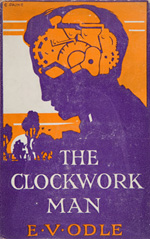
![]() Rhondak101
Rhondak101
1/28/2014
![]()
Technically, E. V. Odle's The Clockwork Man (1923) is not on my TBR shelf. However, if it had been in print during the last few years, it would have been. I've wanted to read it for several years, and just discovered that it was reissued in September 2013 by HiLoBooks in their Radium Age Science Fiction series (1904-1933). Because HiLoBooks are such good chaps, they are serializing each novel they release on their website. I just finished reading the twenty-installment serial, but I will support HiLoBooks's fabulous efforts by purchasing the novel as well.
The unnamed Clockwork Man appears at a village cricket match in an England contemporary with the publication date. He is a time-traveler from the far future, but his clockwork mechanism is damaged, and he never meant to land in the 1920s. His coordination and communication skills are not functioning well, but he looks human enough that the people he encounters take him—at first — to be someone escaped from an asylum: "You had to laugh at the odd-looking figure, or else feel cold all over with another kind of sensation. Of course, this man was mad. He was, in spite of his denial, an escaped lunatic." Yet when he tries to play cricket, he hits the balls three miles away, "spoiling other folks' sport."
I have not read much SF from this time period, so I really did not know what to expect. Like Frankenstein, which many consider the first science fiction novel, The Clockwork Man is very much science philosophy. The majority of the novel explores the thoughts and conversations of three men who first encounter the Clockwork Man at the cricket match. Each man tries to deal with the fact of the Clockwork Man's impossibility in his own way. Dr. Allingham, the village doctor, and Gregg, the captain of the local cricket team, serve as interesting foils. The forty-something Allingham acts much older than his years: "At forty a man does not readily welcome discoveries that may upset his own world of accepted facts." He continually denies the possibility of the Clockwork Man's origins and differences from the human race, hating anything that "disturbed his mental equilibrium." Gregg, the self-assured younger man, is energized and enthralled by progress and ideas of the future: "Time and Space were the obstacles to man's aspirations," and "the clock [inside the Clockwork Man] was the index of a new and enlarged order of things."
The third man who encounters the Clockwork Man is Arthur Withers, an insecure bank clerk. He dreads playing cricket because he fears making a mistake. Arthur loves a local girl but will not marry her because he's afraid that he might lose his job and be unable to support her. The encounter between the Clockwork Man and Arthur in the final chapter provides an important closure to the novel as the Clockwork Man teaches Arthur what being human really means.
This book is very interesting. I think it does suffer from a lack of the presence (and development) of the Clockwork Man character. However, when he does appear, the plot livens up. There is a hilarious encounter between the Clockwork Man, a lamppost, and the local constable, in which the constable believes that the Clockwork Man is drunk but by the end wonders if he is the one who should lay off the gin. The story of the Clockwork Man--who he is, why he is, and where he comes from — unravels very slowly, but the clues do come. Much about his world reminds me of Edwin A. Abbott's Flatland. However, the denouement in the final chapter made me rethink many of the assumptions that I'd made about the Clockwork Man's society.
I can't wait for the physical book to arrive, and I'm sure I will be buying and reading more from HiLoBooks. In fact, I've already scoped out the serialization of Theodore Savage (aka Lest Ye Die, 1928) by Cicely Hamilton to read for the Marxists, Socialists, and Bolsheviks Challenge.